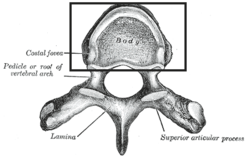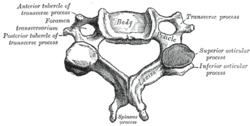- Body of vertebra
-
Bone: Body of vertebra A typical thoracic vertebra, viewed from above. (Body visible at top center.) A cervical vertebra. (Body visible at top center.) Latin corpus vertebrae Gray's subject #20 96 The body is the largest part of a vertebra, and is more or less cylindrical in shape. For vertebrates other than humans, this structure is usually called a centrum.
Its upper and lower surfaces are flattened and rough, and give attachment to the intervertebral fibrocartilages, and each presents a rim around its circumference.
In humans, in anterior view, the body is convex from side to side and concave from above downward. Behind, it is flat from above downward and slightly concave from side to side.
Its anterior surface presents a few small apertures, for the passage of nutrient vessels. On the posterior surface is a single large, irregular aperture, or occasionally more than one, for the exit of the basi-vertebral veins from the body of the vertebra.
Contents
Articular surfaces
The morphology of the anterior and posterior faces of a centrum, where it articulates with other vertebral bodies, partially determine the flexibility and strength of the vertebral column. There are several basic configurations. If both the anterior and posterior surfaces are flat, the vertebra is called "acoelous" or "amphiplatyan"; this type of vertebra is good for dealing with compressive forces. If both surfaces are concave, the vertebra is called "amphicoelous", and permits some motion across a wide range of directions. If the anterior surface is concave and the posterior surface is convex, the vertebra is "procoelous"; the opposite configuration is called "opisthocoelous". Both are varieties of ball-and-socket joints. The ball-and-socket configuration results in less stretching of the spinal cord and thus gives procoelous and opisthocoelous vertebrae greater flexibility than acoelous and amphicoelous vertebrae. Finally, vertebrae with saddle-shaped articular surfaces are called "heterocoelous", which allows vertebrae to flex vertically and horizontally, while preventing twisting motions. Such vertebrae are found in the necks of birds and some turtles.[1]
Additional images
References
External links
- vertebral+body at eMedicine Dictionary
- SUNY Figs 02:01-07 - "Superior and lateral views of typical vertebrae."
This article was originally based on an entry from a public domain edition of Gray's Anatomy. As such, some of the information contained within it may be outdated.Bones of torso (TA A02.2,3, GA 2.96–128) Vertebra General structuresbody of vertebra, vertebral arch (pedicle, lamina, vertebral notch), foramina (vertebral, intervertebral), processes (transverse, articular/zygapophysis, spinous), spinal canalUncinate process of vertebra · Transverse foramen · Anterior tubercle · Carotid tubercle · Posterior tubercle
C1 (lateral mass, anterior arch, posterior arch), C2 (dens), C3, C4, C5, C6, C7Thoracic skeleton specific ribs (1, 2, 9, 10, 11, 12, true – 1–7, false – 8–12, floating – 11–12) · parts (Angle, Tubercle, Costal groove, Neck, Head)SternumThoracic cageSuperior thoracic aperture · Inferior thoracic aperture · Intercostal space · Costal margin · Infrasternal angleCategories:- Bones of the torso
- Vertebral column
- Musculoskeletal system stubs
Wikimedia Foundation. 2010.



